Of all the things I hope we will hold onto in the Post-Covid world is finding time to just sit and appreciate Nature – particularly when we spot something unusual …. if only just to see what happens next.
I captured the following pictures / videos when I stopped to take a closer look when I spotted something that appeared different on one of my walks. A fresh neat hole in the ground or markings around a hole in a tree, a tidy pile of pine needles or ‘sawdust’ have all be created by something. One sometimes needs luck to spot the answer but I’ve found the more patient I’ve been the luckier I’ve been!
The videos are not of TV quality as they were made on a small pocket camera or my phone, but I think they are clear enough to show how patience can be rewarded.
Nuthatch Nest
Nuthatches nest in holes in trees.
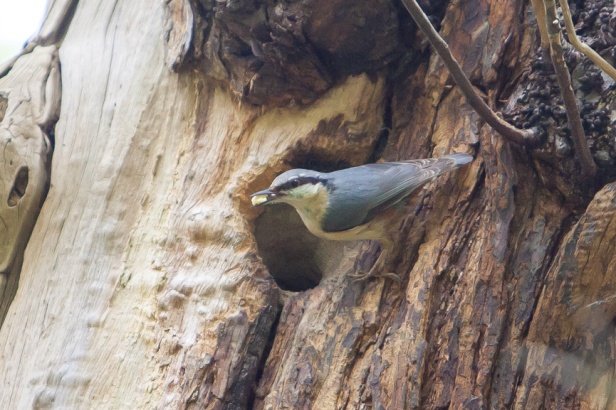
How to spot .. the first clue might, around April, be spotting a nuthatch running up and down the bark of a tree look for grubs. Do not confuse with the treecreeper that is to my mind not so attractive, and can only run upwards. Once at the top it has to fly down and start again. The nuthatch though can do both and ofter hunts for insects near to its nest. So if you spot a nuthatch around April sit quietly and watch. Once it has found a tasty morsel it will fly to its nest to feed it to its young – and thus give away where it has nested.
The other clue might be if you spot a hole in a tree that looks as if its been lined with fresh mud – as can be seen in the above picture. In order to keep potential predators out both the parents work to reduce the size of the entrance with mud. When the young are ready to fledge the parents might have to widen the hole if it’s not been worn away by their coming and going.
The inside of the hole may also be plastered with mud. Pieces of bark and other materials are used on the floor to make ‘bedding’ for the eggs / hatchlings.
Starlings

The clue that something may happening in the following hole is the white staining you can see beneath the hole.

It turned out to be be a startling’s nest.
Watch to the end of the following video and you will see why the parent doesn’t hang around after passing food to its nestling!
I’m not Always Lucky
The following hole may will have been a woodpecker nest from a previous year. It was taken in April when one could expect nesting activity. The markings around the hole show signs of ageing – unlike those around the hole in the second picture.
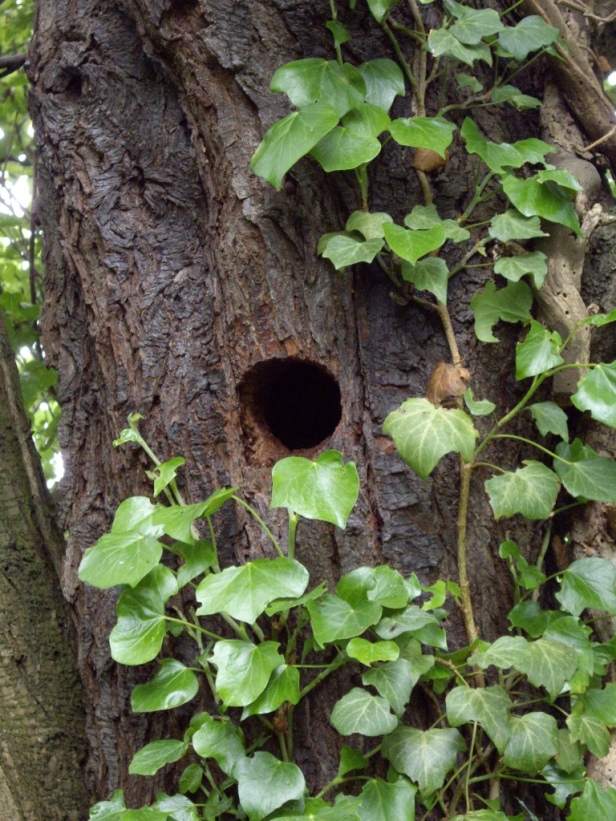
The markings around the hole in the picture below are clearly fresh – as were the chippings on the ground. The hole though was in a tree close to a footpath and only a few feet from the ground. I wonder if the ‘hole-maker’ thought better of nesting in such as exposed place? The photo was taken in May.

Insects ‘nest’ above and below ground
By laying eggs below ground / out of sight an insect does not have to lay so many eggs as their young are not so vulnerable to predators. A small open hole in the ground – looking as if made by a stiletto heel – may indicate that work is in progress. The hole may be being excavated or being stocked up with food on which larvae will live until they emerge as an adult. Once stocked-up with aphids or other small insects or plant material on which the larvae will feed, eggs are laid and the adult will then fill-in or cover the entrance to its ‘nest’.
Digger Wasp
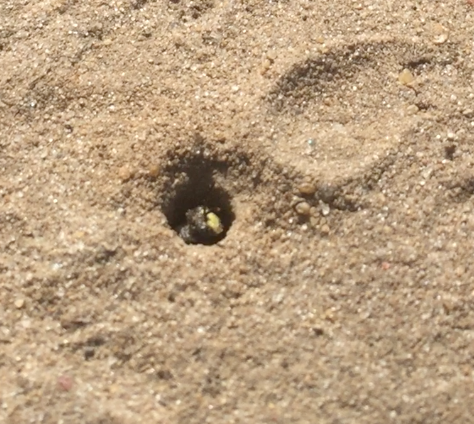
The following is a video of a very cautious Digger Wasp emerging from a hole. My attention was drawn to the site by a low flying insect that was darting about. I then noticed a series of small holes in the ground. The built up of sand around the entrance suggests that the wasp was still excavating a cell or perhaps chambers for its eggs. A wasp will often create more than one burrow in an area as can be seen in to following video.
There are also wasps that will burrow into wood to create a chamber for its eggs. This presumably reduces the need to stock the nest with food as the larvae will be able to feed on the decomposing wood. Spotting ‘sawdust’ around the entrance to a hole as on the sawn off trunk shown below, could well call for a ‘stake-out’ in the hope of spotting a wood wasp or horntail.
The first of the two following pictures was taken in August, the second in September.

A wasp arrived in the next picture but was too ‘camera shy’ for me to capture on video. I’m therefore unsure whether this was the ‘hole-maker’, whether it was just being curious, or perhaps a threat to the the ‘hole-maker’. Another ‘stake-out’ is called for – unless someone else knows?
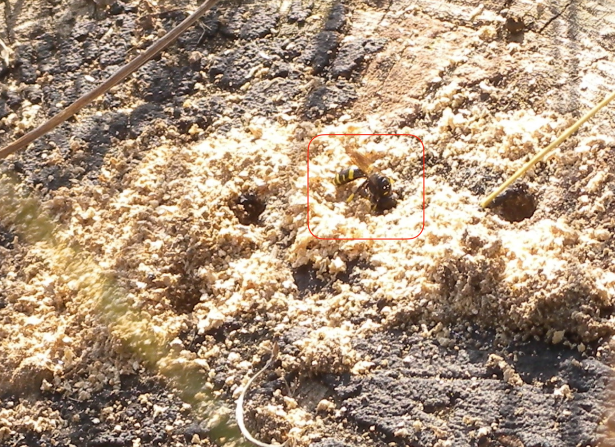
Leaf-Cutter Bee
Not all bees or wasps live in colonies – many live solitary lives. I spotted the bee in the following video flying across a garden carrying a piece of leaf.

Eventually I found it was constructing a nest in a flower trough. It appears to have been cutting pieces from the leaf of a rose bush. (This is another good reason for not spraying plants with insecticides.) The bee will be using the pieces of leaf to construct cells for its eggs and on which the larvae will feed when the eggs hatch.
The following video was made in June.
For insects who ‘nest’ above ground safety coming in numbers and having a good defence system – like wood ants.
Wood Ants
When you see such a neat pile in the woods you could be tempted to think someone has been in the woods clearing up! Look more closely – at a distance – and you will notice the surface is alive with ants. Keep your distance. If the ants believe you are about to attack their nest they will take defensive action – and bite / sting. Following this photo that I took in June, is a video of the surface of the mound / anthill.

A wood ant nest can accommodate as many as 250,000 individual ants, and there could be as much – if not more – of the nest underground – but it would take a brave or foolish person to try and find out as the ants will sting to protect their colony; one sting may not do much harm unless you have an allergic reaction, but hundreds would be bad news.
Look closely at the video and you will see ants on the surface moving material, often twice their size, in order to maintain and extend their nest. You will also notice vent holes that act like ‘chimneys’ to help regulate the temperature of the nest.
Yellow Meadow Ants (Lasis Flavus)
Yellow meadow ants are one of our more common ants that build anthills from soil they excavate as they establish their colony. Mostly these get knocked down in our gardens as we tend flower beds, mow the law or sweep paths / patios. However in fields that are not cultivated the hills can grow – such as those on a bank in Knole Park, Sevenoaks.

Although there may be upwards of 8,000 ants in one colony one does not generally see the ants unless they are disturbed – you can though spot signs of their activity.
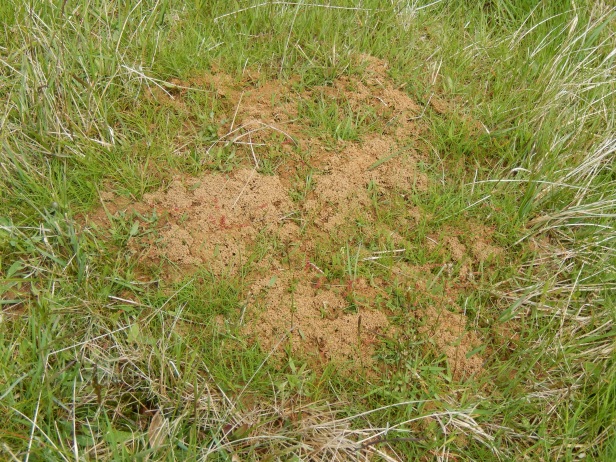
An undisturbed anthill can ‘grow’ at around one litre / year. The queen that lives at the centre of the colony can live for around 14 years – producing fertilised eggs with sperm she ‘received’ on her one and only nuptial flight. {There’s got to be something to learn her – we have to store our sperm at very low temperature.}
If you find a mound significantly larger than 14 litres it is possible another queen has landed on a redundant nest and established a new colony. Had the new queen landed on an active colony its defenders would have killed her. Apparently two new queens can cooperate to establish a new colony – but once established there will be a ‘battle royale‘ that leads to the demise of one of the queens.
Anthills like these, are rather like icebergs. There’s much more below ground than above. The nest can go down to a about one metre to reach damp soil that provides the water the colony needs. The depth also enables the ants to move the eggs / larvae to a lower depth should the temperature in the mound become too great.
Things don’t have to move to be interesting!
The fact that you can’t see anything moving does not mean there is nothing of interest to see.
If you compare the plants growing between the anthills with those growing on top you may notice they are different.

The reason for this is that the soil brought up from the depth of the hill could have a different mineral composition and possibly different acidity, that favours different species of plants.
Weeping Tree- Slime Flux
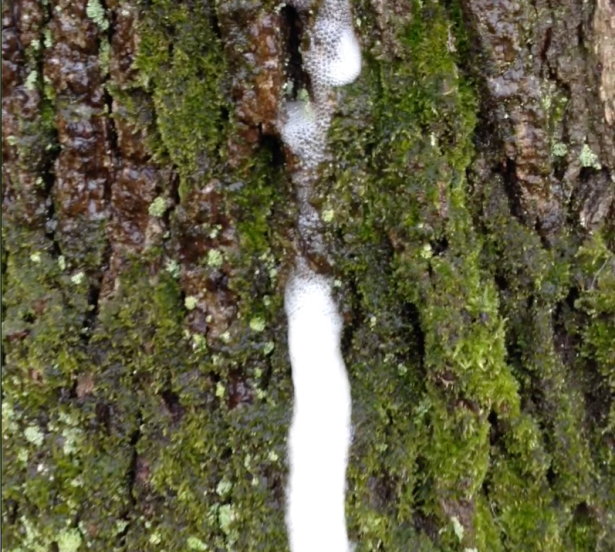
Sadly this is a bad sign. The tree has a deep infection. The bubbles are being created by the escape of carbon dioxide / methane produced by bacteria that is living on the tree’s sap. The work of the bacteria and other pathogens that can enter through the damaged bark, will effectively ‘digest’ the tree from within, and create opportunities for boring inspects to move in and accelerate the tree’s decline. A tree infected in this way will die.
This image / following video is rather ‘dramatic’ as mostly you will see dark staining on the bark of the tree. I’ve found it most notable on beech trees with its smooth bark. The Slime Flux that I spotted was on an oak tree. The fact that it was raining perhaps explains why the foam was so evident and moving. The seepage may have just dried out had it been a dry hot day, and therefore not spottable.
And Finally …
Hopefully the above, taken from my digital scrapbook of things that have caught my attention, shows the value of not rushing from ‘A to B’. Sometimes detours from busy routes can be well rewarded, but I’ve nearly always found reward in taking time to just sit, watch, observe and cogitate.
May we all experience the form of ‘long-covid’ that involves continuing to make time to enjoy the free and natural things that surround us. They’ve always been there – but so many of us have been so busy we’ve not been able see or perhaps enjoy them.
Geoff Ettridge aka Geoff Rambler
9 June 2021
Other of my nature themed blogs:
Year in the life of the Fallow Deer
